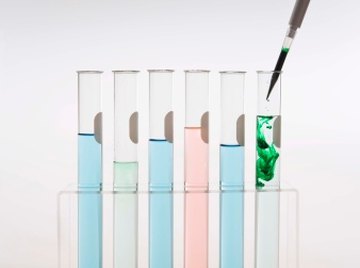
Design an experiment to teach your students how acidity and alkalinity affect enzyme reactions. Enzymes operate best under certain conditions relating to temperature and the level of acidity or alkalinity (the pH scale). Students can learn about enzyme reactions by measuring the time required for amylase to break down starch in buffer solutions covering a range of pHs.
- Iodine solution
- Dimple tiles
- Test tubes
- Amylase (1%)
- Starch (1%)
- Buffer solutions with pHs ranging from 1 to 10
- Syringes
- Timer
Since temperature affects the rates of enzyme reactions, measurements taken on different days are not comparable. Avoid sampling delays that result in underestimating reaction time -- the main source of error in this experiment.
Use an iodine dropper to place one drop of iodine on each of the dimples of dimple tile.
Label each of the test tubes to correspond to each buffer pH that you are testing.
Start with the test tube for pH 6. Use a syringe to add 2 cm3 of amylase to the test tube, then add 1 cm3 of buffer and 2 cm3 of starch. Mix the contents of the test tube thoroughly using a plastic syringe. Wait 60 seconds.
Add one drop of the solution that you mixed in step 3 to the first drop of iodine. The iodine will turn blue-back, indicating that your solution from step 3 still contains starch.
Every ten seconds, add a drop of your solution from step 3 to another iodine drop on the dimple tile. Each iodine drop represents 10 seconds of reaction time. Continue to add your solution to iodine drops until the iodine remains orange, indicating that all the starch is broken down.
Repeat steps 3 through 5 for all of the other pH buffers and quantify reaction time for each pH buffer. Graph pH for each buffer versus reaction time.
Things You'll Need
Warnings
Warnings
- Since temperature affects the rates of enzyme reactions, measurements taken on different days are not comparable. Avoid sampling delays that result in underestimating reaction time -- the main source of error in this experiment.
About the Author
Tricia Lobo has been writing since 2006. Her biomedical engineering research, "Biocompatible and pH sensitive PLGA encapsulated MnO nanocrystals for molecular and cellular MRI," was accepted in 2010 for publication in the journal "Nanoletters." Lobo earned her Bachelor of Science in biomedical engineering, with distinction, from Yale in 2010.
Photo Credits
Jupiterimages/Comstock/Getty Images
